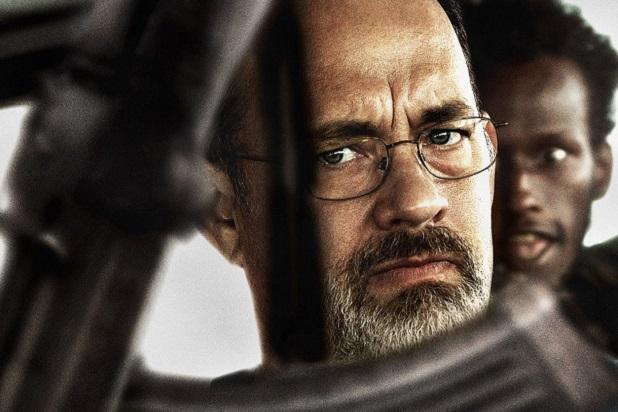
Captain Phillips
“One of the most remarkable things about us is also one of the easiest to overlook: each time we collide with the real, we deepen our understanding of the world and become more fully a part of it.”
Published on http://sensesofcinema.com
There is a haunting absence in Paul Greengrass’s film, Captain Phillips (2013), invisible partly because there’s been so much back and forth about fact and fiction, who was a hero or who should get sued and so on that there’s no room in our discourse for it to become visible. But also, the film narrows our perceptual frame and confines our sense of realism in ways designed to protect and defend us against this haunting presence. “This is an American ship,” as Captain Phillips tells a pirate, and as such the film is directed at Americans who, as viewers, are on board, not to be unsettled but reassured in their own hold on ‘the real’. Nonetheless, collisions occur.
Let me try to sketch what I see.
Transport, getting the goods from here to there is a real world action. True, it is a cyberspace/smartphone world we are in but real three dimensional physical stuff, including bodies, is still out there. Some bodies are well-fed, some are skinny. Captain Phillips (Tom Hanks) does not look malnourished but all the Somali pirates do. Any one of them could have been called ‘Skinny’. None of them is fashionably thin but rather malnourished, cadaver-like thin. The leader, Muse (Barkhah Abdi), called ‘Skinny’, is hard to look at. The way his voice seems to come out as if it is an effort of the vocal chords is alien, and thereby disturbing. His companion pirates have the same look, except for the youngest one who seems to still have some juice in his tissues. But the future does not look very promising for him and for the others. How could they be part of the totally virtualized, robotic cyberspace world for which we are heading?
We are not in such a rapidly approaching robotic sci-fi future in this film. We are very much in a real, physical world, in three-dimensional spaces, bodies of varying dimensions of flesh, sailing in real waters, dangerous waters. Algorithms, you might say, take us only to the water’s edge and then the profit-making enterprise of global shipping cannot be digitized or virtualized. We are not only in the waters of the real but we are sailing too close to the Somali shoreline, too close to what is not an X-Box Somali Pirate game. Everything about a hi-tech cyberspace world cherishes and privileges distance, distancing friends to an on-line ‘society’, distancing ‘others’ outside gated compounds and gentrified strongholds, distancing entire cultures and placing them under perpetual suspicion. There is a cultural need to remain apart, as if guilt haunts the culture.
Captain Phillips respects this need because its narrative style responds to this need in every way. The audience of this film on this American ship does not want to become associated with a world so remote from its own, a world whose plight somehow should perhaps be its concern but this is a concern better deferred than represented.
Proven classic realist techniques are used in Captain Phillips to tie us to the story as if we were in Captain Phillips’ position, thus excluding from sight dangers that would destroy our compact with the Captain and launch ripples extending in wider and wider circles endangering not only the film’s own mythos but also that of an entire culture. Film, like all art, is an entrapment; we are brought into an enclosed space that is not a real space but a substitution, a succedaneum, but one that we accept ‘as if’ it were real. In the classic realist film, collisions between what we already know of the world are worked upon, often brought to a catastrophic state and then resolved. The dark forces are overcome; a good man stands forth.
Captain Phillips, a recognizably flinty, New England man – heritage Americana, played by a perennially wholesome Tom Hanks – packs and goes to the airport, driven by his wife, takes over the command of his ship, inspects it, secures it and thus from the film’s very beginning secures and establishes a niche on the proper side of order, the side for which we too are on board. The threat to our reasonable order of things appears as the four skinny pirates, whom we, like Captain Phillips, try to keep from boarding this scheduled and orderly world we are in. Before the danger to our equilibrium is eliminated, we need to be thrust closer to peril. The pirates take us with them on the lifeboat and we sit there in seat fifteen with him fearing we might be killed. We need to remain in that seat. The SEALS remind us to remain in that seat. We need to continue to identify with Captain Phillips and remain unaware of the haunting absence that has been onboard the MV Maersk Alabama and is now in the lifeboat with us. We fear after repeated unsuccessful attempts that the SEALS will never co-ordinate three kill shots and thus save us. These angry, shouting Somali pirates cannot win; they cannot trump Captain Phillips’ humanitarian concern for the pirate who has a bleeding foot that the good Captain will tend to, if the pirates let him. He is the compassionate gentry in that boat, not of their sub-humanity, but obliged from some more civilized level to conduct himself as the good Captain.
But there is a jeopardy the film cannot disclose or resolve, a collision with the real that opens spaces. Within those spaces in the film the non-diegetic, the not in the story line, inserts itself. What the audience bears with them, what they have taken on board, overspills both the film and the ship’s order. These waters are dangerous; these waters of the real that neither ship nor film can keep from coming on board.
Americans are not alone in a transitional passage in this 21st century, but theirs began with a box cutter assault on U.S. ‘Homeland’ security, not to mention the security of a cultural mass psyche. There is then a special vigilance in the U.S. as to how bodies share this space, this body of earth that does not respond to algorithm commands and can only appear to oblige entrepreneurial self-designing. These Somali pirates are yet another incarnation of a terrorism that seems always to slip below any form of hi-tech vigilance and eradication. This too will weave into the fabric of a haunting absence, an absence drones cannot reach.
When you step down to what the earth is or sail in the waters of this earth, you realize that self-design and self-empowerment and interactive control mean little compared to the material substantiality of the real. You note that zeros and ones do not command Mother Nature’s intensified assault. Neither do they command who has a nourished body and who has not, or who gets to live in an ordered world and who only hopes to survive amid chaos.
A great deal of the U.S.’ military superiority and hi-tech superiority is launched in response to these four skinny Somali pirates. What is most puzzling, at bottom, is the failure of a new Millennial Information/HI-Tech/global capitalistic society to deal with the simple, gross materiality of the world. We witness in Captain Phillips ‘a tale of two worlds’. In one, relations are established through algorithms, virtualized representations and long distance surveillance and command that interface an ‘uncoded’ world. In the other, relations are compelled by the material and objective conditions of an unmediated, unprocessed world maddened by fear and poverty. This encounter then between a cargo freighter, military task forces and Somali pirates is an exemplary encounter, one revealing the incongruity of two worlds occupying the one world of our planet.
What it reveals are two dangers not considered in well-coordinated task force responses. First, the incommensurability of these worlds is a byproduct of the success of one – the First Estate /Post-industrial countries – and the danger that economic superiority has become to the Third Estate or peasant countries. The First Estate countries pursue axiomatically a ‘creative destruction’ of societies that fail to replace reality with a technology serving its own economic priorities. Second, the increasing inconceivability of a Third Estate or peasant country existence in the eyes of the First Estate countries is a danger to the First Estate countries. It is a danger because that inconceivability emerges from a cybertech distancing from the material and physical conditions of the planet. A removed virtualization of the world in the end makes those in the First Estate countries a danger to real conditions of environment, labour, poverty, and the bio-diversity of all living species.
Once detached from our identification with the good Captain, what we see in Captain Phillips is the absurd, almost comical, over-the-top nature of the hi-tech world’s response to four skinny Somali pirates, as if Wile E. Coyote was mounting one of his doomed to failure assaults against the Roadrunner. As ‘terrorists’ dig closer to the impassable bone of existence and abide lower on the tech scale, First Estate responses climb higher into distancing technologies and deeper into a cyber controlled reality. What are most threatening in these four skinny, over-wrought, malnourished pirates are the poverty and its demons that have shaped them. We get close-ups of what computer interfacing and mediating of the world represents only digitally. Beyond the comic opera nature of this response to this low-tech assault on a hi-tech world looms the sorry state of lives that seem alien, as well as the immiserizing poverty that spawns them.
The presence of their misery threatens the hegemony of the idea of perfectly efficient markets, nowhere more loudly proclaimed than in the U.S., the hegemony of a Market Rule in which “all boats are raised,” of an economic system that sorts our Winners from Losers and inspires Losers via a politics of neglect to become Winners. Poverty is yet another low-tech, primordial problem, an unconquerable bone of existence that is met either with a ‘Shock & Awe’ military type response, such as the Liberals’ War on Poverty, or, a denial that such a problem is anything more than a personal problem, certainly not a threat to Market Rule. That denial, which is Neo-liberalism’s approach, has understandably led to what denial in the face of reality always leads to, namely, all that is tragic and unfortunate. The wealthy minority in the U.S. fortify themselves in gated communities, or when marching into poor man’s territory in a ‘gentrifying’ urge, relies on the market to do its ‘creative destruction’ thing.
Americans do not have to look far from their own cities to find a Somalia level misery. They do not have to look far to find responses indicating that the lives of the non-gentry class are as inconceivable as the lives of these Somali pirates. The same absurd madness that launches destroyers, helicopters and parachuting SEALS to the rescue of one man held by four skinny Somali pirates launches an unbelievably absurd politics in the U.S. of further aggrandizing the wealthy few while further impoverishing the many.
A film that encloses reality within a formula that imitates reality and yet denies it remains the means by which a collision with the real nevertheless occurs. This suggests that while we can avoid such collisions in the real world, no art, including film, makes such a compact because its art cannot claim full representation without a collision with the real. A conjured, sleight-of-the hand representation can never be anything more than fractured. Cracks and fissures will appear; a visible dominating presence only serves to suggest what is absent. Although Captain Phillips will not use it’s ‘as if’ reality making ways to unsettle us and thereby risk its hold on us, those ‘as if’ real ways collide with the real itself. Although what is insinuated appears to be a reconfirmation of our mastery of the real, that we not only see all that there is to be seen but we master it, deep and unsettling collisions occur. What haunts us is made manifest; what was absent is brought to presence.
Startling differences are exposed between the ways a much-divided humanity now shares the planet. A computer automated, hi-tech military and cyber-information nation seems unable to see itself as Wile E. Coyote in a ludicrous offense against the Roadrunner. Nor are the many whose lives grow more impoverished each day in the U.S. prepared to see in the faces of these pirates the trajectory of their own lives. Or, tragically, to care about them or comprehend that “each time we collide with the real, we deepen our understanding of the world and become more fully a part of it.” This is the final weave in the fabric of that haunting absence brought to full presence in this film, a full collision of worlds.














2 Comments
Anthony
“The same absurd madness that launches destroyers, helicopters and parachuting SEALS to the rescue of one man…”
So it wasn’t that they were rescuing a shipment of goods?
social media management in hertfordshire
It’s a pity you don’t have a donate button! I’d definitely donate to this fantastic blog!
I suppose for now i’ll settle for book-marking and adding your RSS feed tto my Googgle account.
I look forward to fresh updates and will share this blog with
my Facebook group. Chat soon!
Feell free to surf to my site :: social media management in hertfordshire